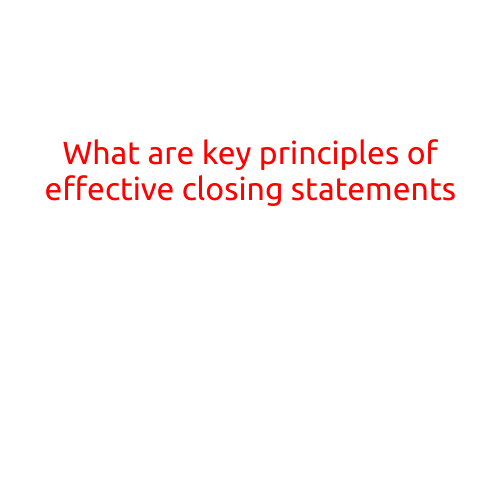
What are the Key Principles of Effective Closing Statements?
When it comes to delivering a winning closing statement, many lawyers struggle to make a lasting impression on the jury or judge. A well-crafted closing statement can be the difference between a verdict in your favor and a defeat. But what makes a closing statement effective? In this article, we’ll explore the key principles of effective closing statements and provide you with the tools you need to craft a compelling argument that resonates with your audience.
Principle 1: Clear and Concise Language
A clear and concise language is essential for an effective closing statement. Avoid using jargon or technical terms that may confuse your audience. Instead, focus on using simple and straightforward language that is easy to understand. Use short sentences and paragraphs to make your message clear and concise.
Principle 2: Focus on the Main Arguments
Don’t try to cover every aspect of your case in your closing statement. Focus on the main arguments that support your client’s position. Highlight the key evidence, witnesses, and facts that support your case, and avoid getting bogged down in minor details.
Principle 3: Use Storytelling Techniques
Storytelling is a powerful tool in any persuasive communication. Use anecdotes, examples, and metaphors to make your argument more relatable and engaging. Storytelling can help your audience connect with your client’s case on a personal level, making your argument more persuasive and memorable.
Principle 4: Emphasize the Consequences
Emphasize the consequences of a verdict in your client’s favor or against. Highlight the benefits and positive outcomes that will result from a favorable verdict, and emphasize the potential harm and negative consequences that may result from an unfavorable verdict.
Principle 5: Use Visual Aids
Visual aids such as charts, graphs, and videos can be a powerful tool in your closing statement. Use visual aids to illustrate key points, highlight key evidence, and make your argument more engaging and memorable.
Principle 6: Anticipate Objections
Anticipate potential objections and address them head-on in your closing statement. This will help to eliminate any doubts or concerns your audience may have and increase the persuasive power of your argument.
Principle 7: Use Emphasis and Tone
Use emphasis and tone to add emphasis to key points and make your argument more convincing. Use inflection and volume to add emphasis to key words or phrases, and use a confident and assertive tone to show that you believe in your argument.
Principle 8: Practice and Prepare
Practice and prepare are essential for delivering an effective closing statement. Rehearse your closing statement several times to ensure that you’re comfortable with the words and the delivery. Prepare for potential questions and objections by anticipating and addressing them head-on.
Conclusion
Crafting an effective closing statement requires careful planning, attention to detail, and a clear understanding of your case and audience. By following the key principles outlined above, you can deliver a winning closing statement that resonates with your audience and helps you achieve your goals.
Additional Tips and Resources
- Use a conversational tone and avoid legalese.
- Highlight the key takeaways and main arguments of your case.
- Use rhetorical devices such as repetition and analogy to emphasize key points.
- Practice your delivery in front of a mirror or record yourself to improve your delivery.
- Use a script or outline to keep your thoughts organized and ensure you cover all the key points.
By following these tips and principles, you can deliver a compelling and persuasive closing statement that helps you achieve your goals and win your case.





